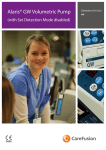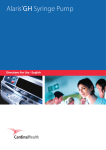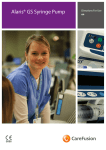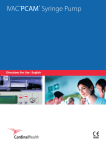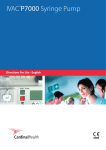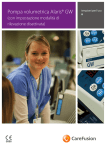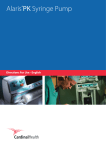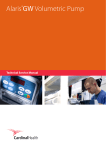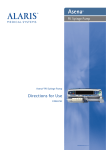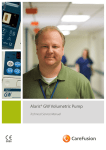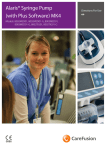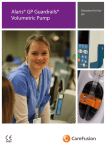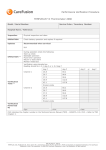Download Alaris®GW Volumetric Pump
Transcript
Alaris GW Volumetric Pump ® Directions For Use - English s Contents Page l Introduction........................................................................................................................................ 2 l About This Manual............................................................................................................................. 2 l Quick Start Guide............................................................................................................................... 2 l Features of the Alaris® GW Volumetric Pump................................................................................. 3 l Controls & Indicators......................................................................................................................... 4 l Symbol Definitions............................................................................................................................ 5 l Operating Precautions...................................................................................................................... 6 l Getting Started................................................................................................................................... 8 l Starting the Infusion.......................................................................................................................... 11 l Secondary/Piggyback Infusions....................................................................................................... 13 l Basic Features..................................................................................................................................... 14 l Configured Options........................................................................................................................... 18 l Alarms................................................................................................................................................. 19 l Warnings............................................................................................................................................. 20 l Flow Sensor Operation...................................................................................................................... 21 l Compatible Infusion Sets ................................................................................................................. 22 l Associated Products . ........................................................................................................................ 24 l Maintenance....................................................................................................................................... 25 l Cleaning and Storage........................................................................................................................ 26 l Disposal............................................................................................................................................... 26 l Specifications..................................................................................................................................... 27 l IrDA, RS232 and Nurse call Specification........................................................................................ 29 l Trumpet Curves & Start-up Curves................................................................................................... 30 l Technical Description........................................................................................................................ 31 l Products and Spare Parts.................................................................................................................. 32 l Service Contacts ................................................................................................................................ 33 l Document History ............................................................................................................................. 33 l Warranty . ........................................................................................................................................... 34 l Index.................................................................................................................................................... 1000DF00107 Issue 3 /36 35 Introduction The Alaris® GW Volumetric Pump (herein after referred to as "Pump") is a small lightweight volumetric infusion pump that provides accurate and reliable infusions over a range of rates. The ideal pump for general care and critical care. Intended Use: The pump is designed to meet the infusion requirements within the operating environment specified in this Directions For Use (DFU) including general wards, critical and intensive care, neonatal, outpatients clinics, operating rooms and accident and emergency rooms. The pump can be used in the Intravenous and epidural routes of delivery of fluids and medications including but not limited to; hydration, total parenteral nutrition, antibiotics, blood, blood products, analgesics, anaesthetics and chemotherapy. The Asena® brand name has been recently changed to the Alaris® brand name. This change in brand name has no effect on the intended use or functionality of the product. Recommended disposable products for use with this product may refer to either the Asena® brand name or Alaris® brand name and both types are suitable for use with this infusion pump. About This Manual The user must be thoroughly familiar with the pump described in this manual prior to use. All illustrations used in this manual show typical settings and values which may be used in setting up the functions of the pump. These settings and values are for illustrative use only. The complete range of settings and values are detailed in the specifications section. Quick Start Guide 1. Half fill the drip chamber. 2. Press a to switch pump on. 3. Open in-line clamp. 4. Prime (E) set: Press b once. Whilst E is displayed press b again and hold to clear all visible air from the line. 5. Enter rate using h / f. 6. Press e once to confirm and scroll to VTBI. 7. Enter VTBI using h / f , or, if using a Flow sensor, the VTBI can be switched off by scrolling f until OFF is displayed. 8. Press e to confirm and scroll to VI. 9. If necessary, press c to clear VI. 10. Connect Infusion set to the patient access device. . 11. Press d to start infusion. 1000DF00107 Issue 3 /36 Features of the Alaris® GW Volumetric Pump Main Display Displays the infusion rate, VTBI, VI and time remaining for VTBI / Time infusions. Display will flash when pump is operating on battery. Display Indicators Keypad Flow Stop Mechanism When activated the mechanism will stop fluid flow. Flow Direction Label Air Sensor Pressure Sensor Bevel Releases the flow stop mechanism lever arm when the door is closed. Door Latch Press outer latch to open the pump door. Tubing Guide Guide to assist in the loading of the Infusion set. Release Lever For Rotating cam. Rotating Cam To lock onto the rectangular bars. RS232 / Nurse call Connector Flow Sensor Interface Mains Fuses Mains Inlet Folded Pole Clamp Potential Equalisation (PE) connector Infra Red Communications port (IrDA) 1000DF00107 Issue 3 /36 Controls and Indicators Controls: Symbol Description a d c b l e hf ON/OFF button - Press once to switch the pump ON. Press and hold down for approximately 3 seconds to switch the pump OFF. RUN/HOLD button - Press to start the infusion or to put the infusion on hold. CLEAR/SILENCE button - Press to silence alarm for 1 minute. The alarm will resound after this time. Resets numeric values to zero. PRIME/BOLUS button - Primes the Infusion set. Administers bolus during the infusion. PRIMARY/SECONDARY button - Switches the pump between Primary and Secondary infusion modes. (If enabled). ENTER button - Scrolls between rate, time, VTBI and total volume infused (VI). Enters values for selected infusion / configuration parameters. Confirms the rate during an infusion titration. CHEVRON keys - Increases or decreases the infusion rate, TIME limit and VTBI. Press and hold to increase the selection speed. Used to adjust user selectable options Indicators: (when illuminated) Symbol S RATE VTBI VI TIME MICRO SEC ml/hr Description AC POWER indicator - The pump is connected to an AC power supply. The pump is displaying the infusion rate in millilitres per hour (ml/h). The pump is displaying the Volume To Be Infused (VTBI) in millilitres (ml). The pump is displaying the Volume Infused (VI) in millilitres (ml). The pump is displaying the infusion time in hours : mins. The pump is operating in the MICRO Mode. When not illuminated the pump is in the STANDARD Mode. The pump is operating in the SECONDARY Mode. When not illuminated the pump is in the PRIMARY Mode. (Millilitres / hour) When ml is illuminated the pump displays the rate, VTBI or VI. When the hr is illuminated the pump displays the rate or infusion time. 1000DF00107 Issue 3 /36 Symbol Definitions Labelling Symbols: Symbol w x > k O r s T t + A U W V W X Y Description Attention (Consult accompanying document) Potential Equalisation (PE) Connector RS232/Nursecall Connector. Type CF applied part. (Degree of protection against electrical shock) Protected against vertically falling drops of water Alternating Current Device complies with the requirements of the EC Directive 93/42/EEC. Registered with the CE Mark. Date of Manufacture Manufacturer Connector for Flow Sensor Important Information Not for Municipal Waste Fuse rating Infusion indicator - Infusing at a normal Infusion indicator - Infusing in MICRO mode. Infusion indicator - Displays fluid drops detected by the flow sensor when infusing at a normal rate. Infusion indicator - Displays fluid drops detected by the flow sensor when infusing in MICRO mode. 1000DF00107 Issue 3 /36 Operating Precautions Infusion Sets • • • j • • • • • To ensure correct and accurate operation, only use Cardinal Health single use infusion sets described in this directions for use. It is recommended that Infusion sets are changed in accordance with the Directions for Use. Carefully read the Directions For Use supplied with the Infusion set prior to use. Use of non-specified Infusion sets may impair the operation of the pump and the accuracy of the infusion. When combining several apparatus and/or instruments with Infusion sets and other tubing, for example via a 3-way tap or multiple Infusion, the performance of the pump may be affected and should be monitored closely. Uncontrolled flow may result if the Infusion set is not properly isolated from the patient i.e. closing a tap in the set or activating an in-line clamp/roller clamp. The Infusion set may be fitted with an in-line clamp, which can be used to occlude tubing in case it is required to stop fluid flow. The Alaris® GW Volumetric Pump is a positive pressure pump, which should use Infusion sets fitted with luer lock fittings or equivalent locking connectors. To infuse from a burette, close the roller clamp above the burette and open the clamp on the vent on top of the burette. Discard Infusion set if the packaging is not intact or the protector cap is detached. Ensure sets are not kinked as this may occlude the tubing. Mounting the Pump ^ %; • • The fluid height in the container must not be more than 1 metre above the patients heart. Do not mount the pump in a vertical position with the AC power inlet pointing upwards as this could affect electrical safety, in the event of a fluid spill over the pump. Operating Pressure • The pumping pressure alarm system is not designed to provide protection against, or detection of, IV complications which can occur. Latex Content • The Alaris® GW Volumetric Pump does not contain any latex. Alarm Conditions $ • Several alarm conditions detected by this pump will stop the infusion and generate visual and audible alarms. Users must perform regular checks to ensure that the infusion is progressing correctly and no alarms are operating. Using Collapsable bags, Glass Bottles & Semi Rigid containers • It is recommended that the air vent be opened on the Alaris® GW Volumetric Pump set if using glass bottles or semi-rigid containers, to reduce the partial vacuum formed as the fluid is infused from the container. This action will ensure the pump can maintain volumetric accuracy whilst the container empties. The action of opening the air vent for semi-rigid containers should take place after the spiking of the container and priming of the drip chamber. Steps for the Collapsable bags Steps for Semi-rigid containers Follow steps 1 to 3 as shown for the semi-rigid containers, however do not open vent as in step 4, but prime the set as per step 5. Ensure the bag outlet is fully pierced before filling the drip chamber. 2. 3. 4. Spike the container Fill drip chamber to fill line Open the air vent to allow pressure equalisation - ready for infusion 5. 1. Close the roller clamp 1000DF00107 Issue 3 /36 Prime the set by opening / closing the roller clamp Operating Precautions (Continued) Operating Environment • • • When using any infusion pump in conjunction with other pumps or devices requiring vascular access, extra care is advised. Adverse delivery of medication or fluids can be caused by the substantial variation in pressures created within the local vascular system by such pumps. Typical examples of those pumps are used during dialysis, bypass or cardiac assist applications. This pump is suitable for use in Hospital and clinical environments other than domestic establishments and those directly connected to the public single phase AC mains power supply network that supplies buildings used for domestic purposes. However, it may be used in domestic establishments under the supervision of Medical professionals with additional necessary appropriate measures. (Consult Technical Service Manual, appropriately trained technical personnel or Cardinal Health for further information). This pump is not intended to be used in the presence of a flammable anaesthetic mixture with air or oxygen or nitrous oxide. Electromagnetic Compatibility and Interference / & • • • • This pump is protected against the effects of external interference, including high energy radio frequency emissions, magnetic fields and electrostatic discharge (for example, as generated by electrosurgical and cauterising equipment, large motors, portable radios, cellular telephones etc.) and is designed to remain safe when unreasonable levels of interference are encountered. In some circumstances the pump may be affected by an electrostatic discharge through air at levels close to or above 15kv; or by radio frequency radiation close to or above 10v/m. If the pump is affected by this external interference the pump will remain in a safe mode; the pump will duly stop the infusion and alert the user by generating a combination of visual and audible alarms. Should any encountered alarm condition persist even after user intervention, it is recommended to replace that particular pump and quarantine the pump for the attention of appropriately trained technical personnel. This pump is a CISPR 11 Group 1 Class B device and uses RF energy only for its internal function in the normal product offering. Therefore, its RF emissions are very low and are not likely to cause any interference with the nearby electronic equipment. However, this pump emits a certain level of electromagnetic radiation which is within the levels specified by IEC/EN60601-1-2 and IEC/EN60601-224. If the pump interacts with other equipment, measures should be taken to minimise the effects, for instance by repositioning or relocation. For further information on electromagnetic compatibility, please consult Technical Service Manual, 1000SM00006 (available from the web: www.cardinalhealth.com/alaris). Earth Conductor d • • • The Alaris® GW Volumetric Pump is a Class I device, therefore must be earthed when connected to an AC power supply. This pump also has an internal power source. When connected to an external power source, a three-wire (Live, Neutral, Earth) supply must be used. If the integrity of the external protective conductor on the AC power cable has been compromised, the pump should be disconnected from the AC power source and operated utilising the internal battery. Hazards B • • m V * • • • An explosion hazard exists if the pump is used in the presence of flammable anaesthetics. Exercise care to locate the pump away from any such hazardous sources. A fire hazard may exist if the pump is used in the presence of high oxygen concentrations. Dangerous Voltage: An electrical shock hazard exists if the pump’s casing is opened or removed. Refer all servicing to qualified service personnel. Electrostatic discharge (ESD) precautions are required when connecting RS232/Nurse Call. Touching the pins of the connectors may result in ESD protection failure. It is recommended that all actions must be taken by appropriately trained personnel. If this pump is dropped, subjected to excessive moisture, fluid spillage, humidity or high temperature, or otherwise suspected to have been damaged, remove it from service for inspection by a qualified service engineer. When transporting or storing the pump, use original packaging where possible, and adhere to temperature, humidity and pressure ranges stated in the Specifications section and on the outer packaging. 1000DF00107 Issue 3 /36 Getting Started A Before operating the pump read this Directions For Use (DFU) manual carefully. Initial Set Up 1. 2. Check that the pump is complete, undamaged and that the voltage rating specified on the label is compatible with your AC power supply. Items supplied are : l l l l 3. Alaris® GW Volumetric Pump User Support CD (Directions For Use) AC Power Cable (as requested) Protective Packaging Connect the pump to the AC power supply for at least 2½ hours to ensure that the internal battery is charged (verify that the S is lit). A The pump will automatically operate from its internal battery if the pump is switched on without being connected to the power supply. Should the pump fail to perform correctly, replace in its original protective packaging, where possible and contact a qualified service engineer for investigation. Pole Clamp Installation A pole clamp is fitted to the rear of the pump and will provide secure fixing to vertical I.V. poles of a diameter between 15 and 40 mm. Recessed area * * 1. Pull the folded pole clamp towards you and unscrew the clamp to leave enough room for the size of the pole. 2. Place pump around pole and tighten screw until the clamp is secured to the pole. A Never mount the pump such that the Infusion stand becomes top heavy or unstable. Ensure pole clamp is folded away and stored within recessed area at the rear of the pump before connecting to a Docking Station/Workstation* or when not in use. Docking Station/Workstation* or Equipment Rail Installation Rectangular bar Release lever The rotating cam can be fitted to the rectangular bar on the Docking Station/Workstation* or equipment rails measuring 10mm by 25mm. Rotating cam 1. Align the rotating cam on the rear of the pump with the rectangular bar on the Docking Station/Workstation* or the equipment rail. 2. Push the pump firmly onto the rectangular bar or equipment rail. Ensure that the pump 'clicks' securely into position onto the rail or bar. 3. To release, push the release lever and pull the pump forwards. A It is recommended that infusion bags be located on a hanger directly above the pump with which they are being used. This minimises the potential for confusion of Infusion sets when multiple volumetric pumps are used. *Alaris® DS Docking Station, Asena® IDS Docking Station & Alaris® Gateway Workstation. 1000DF00107 Issue 3 /36 Getting Started (Continued) - Loading an Infusion Set A Ensure the appropriate Infusion set for the fluid/drug to be infused has been selected. Follow the instructions supplied with the individual Infusion set. Use of non-specified Infusion sets may impair the operation of the pump and the accuracy of the infusion. For Alaris® GW Volumetric Pump Infusion sets refer to 'Infusion Sets' section of the DFU. Position the IV fluid container to avoid spillage onto the pump. Ensure that the tubing is inserted completely into the pumping channel, avoiding any slack. When using 273-003 Infusion sets, ensure a separation of at least 30cm is maintained between the pump and the upper Y- site. 1. 2. 1000DF00107 Issue 3 Close the in-line clamp on the Infusion set. Press the door latch to open the tubing cover door. Release the flow stop mechanism by pushing the lever arm up and to the right. 3. Insert the infusion set from left to right into the slot provided, following the flow direction label. Make sure that the infusion set is pressed firmly past the constriction points and into the slots on either side of the casing. Avoiding any slack, close the door. 4. Re-engage the flow stop mechanism by pushing the lever left and down. 5. Close the tubing cover door. Use the recesses in the cover door to press the door firmly to ensure the latch is correctly applied. Open in-line clamp on the Infusion set. 6. Observe fluid chamber and check for no fluid flow. /36 Getting Started (Continued) Power On/Off To power up the pump: To power down the pump: k 1. Press the a button once and release. 2. Check: l A high pitch sounder is activated for 3 seconds during this time the main speaker “beeps” once upon power up sequence. l All display segments and all indicators are lit. l If an error occurs during self-test the pump will alarm. Hold for 3 seconds. 1. Press and hold a. The pump will display OFF3-OFF2-OFF1. 2. If the a button is released during the countdown the pump will not power down and it will return to its previous state. After this self-test the pump will display last rate setting entered or zero, depending on the configuration. A If the pump alarms, segments / indicators do not light up correctly or 2 audible sounds are not heard, then the pump must be powered down immediately, and a qualified service engineer contacted. If transportation to an engineer is necessary, it is recommended to use the original protective packaging. Priming the Infusion Set A When using Infusion sets without an anti-siphon valve e.g. 273-004, 273-007 and 273-008, the set can be primed without using the pump. 1. Ensure the pump is switched on and in-line clamp is open. 2. Load the Infusion set (see “Loading the Infusion Set). Priming: Hold Down ! 3. Press b button once E will be displayed. 4. Press and Hold b button while E is still displayed, prime the Infusion set until there is no visible air in the IV line (according to hospital protocol). 5. Attach the set to the patient or other Infusion set. 6. Start the infusion (see starting the infusion). A Use the prime function to fill the Infusion sets before starting an infusion. Never connect the Infusion set to the patient during the priming process. The prime (E) volume delivered will not be subtracted from the VTBI, or added to the total volume infused. Automatic Set Detection The pump automatically tests that a compatible Cardinal Health Infusion set has been loaded correctly (refer to "Compatible Infusion sets" section of this DFU). The test will occur at the start of the first infusion after the pump is switched on or after the door has been opened; the test takes a maximum of 20 seconds to complete. If the pump fails to detect that the Cardinal Health Infusion set has been loaded correctly, then the pump will alarm and display Q refer to "Alarms and Warnings" section of this DFU. 1000DF00107 Issue 3 10/36 Starting the Infusion with a Flow Sensor l l The pump is switched on. The Infusion set has been primed (refer to “Priming the Infusion Set” section of this DFU). l The in-line clamp is open. l The flow sensor is connected (refer to “Flow Sensor Operation” section of this DFU). l U indicates a drop is detected by the flow sensor during infusion. Check: ) Standard Mode with VTBI / Time Infusion on Standard Mode Enter infusion rate : 4 4 w z Enter volume to be infused : 4 3 1 Volume to be infused : OR Set VTBI to OFF : Time : Volume infused - Clear or Accept (start infusion) Volume infused - Clear or Accept (start infusion) 1. 2. 3. 4. 5. Enter infusion rate using the f h keys. Press e button once to scroll to VTBI. Enter VTBI using the f h keys or switch VTBI off by pressing the f button until OFF is displayed. Press e button to scroll back or c to clear VI if required. Press d button to start infusing. 1. 2. 3. 4. 5. Micro Mode Micro Mode with VTBI / Time Infusion on Enter infusion rate : Enter volume to be infused : u u w 2 u 3 x Volume to be infused : Time : OR Set VTBI to OFF : Volume infused - Clear or Accept (starts infusion) Volume infused - Clear or Accept (starts infusion) Enter VTBI using the f h keys. Press e button once to scroll to TIME. Enter TIME using the f h keys. Press e button to scroll back or c to clear VI if required. Press d button to start infusing. 1. 2. 3. 4. 5. Enter infusion rate using the f h keys. Press e button once to scroll to VTBI. Enter VTBI using the f h keys or switch VTBI off by pressing the f button until OFF is displayed. Press e button to scroll back or c to clear VI if required. Press d button to start infusing. 1000DF00107 Issue 3 1. 2. 3. 4. 5. 11/36 Enter VTBI using the f h keys. Press e button once to scroll to TIME. Enter TIME using the f h keys. Press e button to scroll back or c to clear VI if required. Press d button to start infusing. Starting the Infusion without a Flow Sensor l l The pump is switched on. The Infusion set has been primed (refer to “Priming the Infusion Set” section of this DFU). l The in-line clamp is open. l Check: indicates infusion without a flow sensor being used. ( Standard Mode with VTBI / Time Infusion on Standard Mode Enter infusion rate : 4 4 7 Enter volume to be infused : 4 3 8 Volume to be infused : Volume infused - Clear or Accept (start infusion) 1. 2. 3. 4. 5. Enter infusion rate using the f h keys. Press e button once to scroll to VTBI. Enter VTBI using the f h keys. Press e button to scroll back or c to clear VI if required. Press d button to start infusing. Time : Volume infused - Clear or Accept (start infusion) 1. 2. 3. 4. 5. Micro Mode Enter VTBI using the f h keys. Press e button once to scroll to TIME. Enter TIME using the f h keys. Press e button to scroll back or c to clear VI if required. Press d button to start infusing. Micro Mode with VTBI / Time Infusion on Enter infusion rate : Enter volume to be infused : u u 9 u 3 : Volume to be infused : Time : Volume infused - Clear or Accept (starts infusion) Volume infused - Clear or Accept (starts infusion) 1. 2. 3. 4. 5. Enter infusion rate using the f h keys. Press e button once to scroll to VTBI. Enter VTBI using the f h keys. Press e button to scroll back or c to clear VI if required. Press d button to start infusing. 1000DF00107 Issue 3 1. 2. 3. 4. 5. 12/36 Enter VTBI using the f h keys. Press e button once to scroll to TIME. Enter TIME using the f h keys. Press e button to scroll back or c to clear VI if required. Press d button to start infusing. Secondary / Piggyback Infusions Secondary (or piggyback) Infusion mode is only available if configured, refer to “Configurable Options” section of this DFU. Secondary Infusion mode is used to administer an intermittent fluid / drug solution e.g. 4 hourly antibiotic infusion using: 1. A primary infusion set with an in-line check valve before the Y-Injection site e.g. 273-003. 2. A secondary infusion set e.g. 72213, S75213, C20128 and C20350. A 1. 2. 3. 4. 5. 6. Primary fluid container must hang lower (approx. 20cm lower) than the secondary fluid container to allow the secondary infusion to run. Primary infusion will restart on completion of the secondary infusion. Set the primary infusion, but do not start (refer to “Starting the Infusion” section of this DFU). If pump is running press d button to put pump on hold. Prime Secondary Infusion set, following the instructions supplied. Close the in-line clamp on the secondary set. Connect secondary Infusion set into upper Y-injection site of the primary Infusion set. Lower primary fluid container using extension hook supplied with the secondary Infusion set. Press l button and S will be displayed. Rate / Volume 7. 8. 9. OR VTBI / Time Enter required rate using the hf keys. Press e button to scroll to VTBI. Enter VTBI using the hf keys. 7. 8. 9. Enter VTBI using the hf keys. Press e button to scroll to TIME. Enter TIME using hf keys. 10. Open the in-line clamp on the secondary set. 11. Press e button to scroll further, or press d button to start the secondary infusion. Ensure the SEC (Secondary) indicator is lit. The infusion rate will automatically revert to the primary infusion rate when the secondary infusion is complete. On completion of the primary infusion the pump will continue at Keep Vein Open rate (KVO) rate. A During primary / secondary infusion of 2 drugs into a single lumen line, it is essential to ensure drug / fluid compatibility by consulting a drug compatibility chart or local pharmacist, prior to infusion. The secondary set connects to the upper Y-connection on the primary Infusion set. To set the Secondary Infusion the pump must be on G or not running. Secondary infusion rates above 270ml/h may cause simultaneous flow from secondary and primary fluid sources. Typical Secondary infusions: Secondary Fluid Container Usually a smaller container e.g. 50ml, 100ml, 200ml or 250ml. IV Pole Extension Hook 2 Normally included with the secondary Infusion set. Primary Infusion set must hang lower to allow the secondary infusion to run and primary infusion to restart on completion of the secondary. 1 Primary Fluid Container In-line Clamp e.g. roller clamp. Primary Infusion set Secondary Infusion Set e.g. 273-003 with an upper Y-injection site. e.g. 72213. Usually shorter tubing to reach the Y-site on the primary Infusion set. In-line Clamp e.g Roberts clamp. Upper Y-Injection Site on Primary Infusion Set. Prevents secondary infusions from flowing back up the primary Infusion set instead of to the patient. Check Valve A 1000DF00107 Issue 3 13/36 If using a flow sensor it must be on the primary Infusion set. Basic Features Bolus Infusions Rate Titration Press To Confirm To administer a bolus infusion: Hold Down Z 0 The rate can be increased or decreased without interrupting the infusion. A If the new rate selected is not confirmed the pump will revert to the current rate and no change in the infusion rate will occur. 1. Press b button once and C will be displayed. Press and Hold b button while C is still displayed, release b button after administering the desired bolus volume. Bolus volume given will be added to the total volume infused (VI) and subtracted from the volume to be infused (VTBI). 2. Panel Lock Optimising the Pumps Performance The Panel Lock feature minimises the risk of unintentional changes to the infusion settings, whilst infusing. Pump performance may be optimised by moving a new section of the infusion set in the pumping mechanism every 24 hours. To insert a new section of tubing: p If Panel Lock is enabled then button presses. displays for all (non-operational) 1. Press d to place the infusion on HOLD. 2. Ensure the in-line clamp is closed. 3. Open the pump door, release the flow stop mechanism and move the Infusion set approximately 15cm along. 4. See “Loading the Infusion Set”. 5. Close the door, press d to restart the infusion. Panel Lock prevents button operation with the exception of: Scrolling between infusion parameters using the e button. Muting the alarm using the c button. Pausing / resuming the infusion using the d button. Hold Mode KVO (Keep Vein Open) Rate n Press d to pause the infusion. Press d again to resume the infusion. A call back alarm will activate if the pump is left on G for more than 2 minutes. 1000DF00107 Issue 3 At the end of infusion, the pump will continue to infuse at a very low rate (refer to “Specifications” section of this DFU). KVO is used to keep the patients vein open, in order to prevent blood clots and catheter occlusions. A 14/36 If the KVO rate is greater than the set infusion parameters then the pump will continue to infuse at the set infusion rate. If the KVO rate has been configured to OFF the pump will stop infusing and generate an alarm. Basic Features (continued) Changing the Infusion Set 1. 2. 3. 4. 5. 6. 7. 8. Press d to put the pump ON HOLD. Close in-line clamp and ensure the IV access to the patient is isolated. Disconnect the Infusion set from the patient. Open pump door and remove Infusion set from the pump and discard the set and fluid container according to hospital protocol. Place new Infusion set into pump, see “Loading the Infusion Set” Squeeze the drip chamber approximately half full or up to fill line (if the drip chamber is marked) with fluid. Prime the set manually. Restart infusion, see "Getting Started". A When changing the Infusion set or the fluid container use aseptic technique according to hospital protocol. It is recommended that Infusion sets are changed in accordance with the Directions for Use. Carefully read the Directions For Use supplied with the Infusion set prior to use. The set change interval is 24 hours. Changing the Fluid Container 1. 2. 3. 4. 5. Press d to put the pump ON HOLD. Remove bag spike on Infusion set from empty / used container. Discard empty / used container according to hospital protocol. Insert spike into new container. Squeeze the drip chamber approximately half full or up to fill line (if the drip chamber is marked) with fluid. Restart infusion, see "Getting Started". A When changing the Infusion set or the fluid container use aseptic technique according to hospital protocol. It is recommended that Infusion sets are changed in accordance with the Directions for Use. Carefully read the Directions For Use supplied with the Infusion set prior to use. SmartSite® Needle-Free System Instructions SmartSite® Needle-Free Valve is designed to permit safe gravity flow and automated flow, injection and aspiration of fluids without the use of needles by utilising luer lock and luer slip connectors. A Precautions: Discard if packaging is not intact or protector caps are unattached. If SmartSite® Needle-Free Valve is accessed by a needle in an emergency the valve will be damaged causing leakage. Replace SmartSite® Needle-Free Valve immediately. SmartSite® Needle-Free Valve contraindicated for blunt cannula system. DO NOT leave slip luer syringes unattended. DIRECTIONS - Use Aseptic Technique 1. Prior to every access, swab top of SmartSite® Needle-Free Valve port with 70% Isopropyl alcohol (1-2 seconds) and allow to dry (approximately 30 seconds). NOTE: Dry time is dependent on temperature, humidity, ventilation of the area. 2. Prime valve port. If applicable, attach syringe to SmartSite® Needle-Free Valve port and aspirate miniscule air bubbles. 3. Replace according to set change interval (see above) or 100 activations which ever occurs first. For infusions of blood, blood products or lipid emulsions replace every 24 hours. NOTE: During use of Smartsite® Needle-Free Valve port, fluid may be observed between the housing and blue piston. This fluid does not enter the fluid path and requires no action. For product questions or needle-free valve educational materials contact your Cardinal Health representative. The Center for Disease Control, Intravenous Nurses Society (USA) and other organizations publish guidelines useful in developing facility guidelines. Consult facility protocols. 1000DF00107 Issue 3 15/36 Basic Features (continued) Clearing Air-In-Line 1. Press d button to silence the air-in-line alarm and put the pump on hold. 2. Close the in-line clamp. 3. Open the door to view the air bubble. NOTE: Air-in-line alarms can be activated by both single bubbles and bubbles accumulated over time. See page 25 for full description. If the size of the air bubble is considered to be: CLINICALLY INSIGNIFICANT CLINICALLY SIGNIFICANT 4. Release the flow stop mechanism by pushing the lever arm up and to the right. 4. Disconnect the Infusion set from the patient and ensure the IV access to the patient is isolated. 5. Close the door. Flow Stop Mechanism Lever Arm 6. Open the in-line clamp. 7. Press the b button once and E will be displayed. ! 8. Press and hold the b button while E is still displayed until there is no visible air in the IV line (according to hospital protocol). 9. Close the in-line clamp. 10.Attach the Infusion set to the patient. 11.Open the in-line clamp and restore the IV access to the patient. Air Bubble 5. Move the tubing along to the right (towards the patient) to ensure the air bubble is outside of the pumping segment. 12.Press the d button to resume the infusion. Air Bubble 6. Close the door. 7. Open the in-line clamp. A 8. Press the d button to resume the infusion. A Use aseptic technique according to hospital protocol. Infusion sets without an in-line anti-siphon valve must be clamped before disconnecting from the patient and the prime (E) procedure will not be necessary to remove the air-in-line, as the air can be removed by gravity. 1000DF00107 Issue 3 16/36 Basic Features - User Selectable Options A To set the user options the pump must be on G or in set-up mode, and the relevant user selectable options are available. See also “Configurable Options” section in this DFU. Setting the Occlusion Pressure Level Setting the Alarm Volume g g g 2 Seconds 2 Seconds s x1 (Dependent on User Select Mode Options) t Alarm Volume: 1 = Low, 7 = High 1. Press e button and hold for 2 seconds and will be displayed. 2. Select HI, nor or Lo using the h f keys to set the occlusion pressure level to High, Normal or Low. 3. Press e button to return to G or set-up mode, or next option. 1. Press e button and hold for 2 seconds or press e button until is displayed. 2. Select an alarm volume between 1 and 7 using the h f keys. 3. Press e button to G or set-up mode, or next option. Setting a VTBI / Time Infusion g g Setting to Micro Mode g g 2 Seconds 2 Seconds x2 x3 (Dependent on User Select Mode Options) (Dependent on User Select Mode Options) r q 1. Press e button and hold for 2 seconds or press e button twice and R is displayed. 1. Press e button and hold for 2 seconds or press e button until T is displayed. 2. Select On or OFF using the h f keys to turn 2. Select On or OFF using the h f keys to turn micro mode on or off. the VTBI / time infusion setting on or off. 3. Press e button to return to G or set-up mode, or next option. 3. Press e button once to return to G or set-up mode, an audible sounder will confirm the status. Make sure that the TIME indicator is lit if set to on. Make sure that the MICRO indicator is lit if set to on. The TIME increases / decreases in rate dependant units e.g. [email protected]/h is 6mins, therefore 0:06 is displayed. 1000DF00107 Issue 3 17/36 Configurable Options Sheet A The default settings are configurable as displayed in brackets in the table below. Each of the configurable options has a code which must only be altered by a qualified service engineer with reference to the technical service manual (TSM) for this product (Technical Service Manual reference: 1000SM00006). Description Range Default Enable VTBI / time infusions (On / OFF) OFF Maximum priming volume (OFF, 1 to 40 ml) 40ml Clear infusion parameters to zero on power - up (On / OFF) OFF Maximum VTBI in MICRO Mode (0.1 to 999 ml) 999ml Bolus rate (1 to 999ml/h) 400ml/h Maximum bolus volume (OFF, 1 to 99ml) 5ml Keep vein open rate (OFF, 1.0 to 5.0 ml/h) 5.0ml/h Air in line alarm volume - single bubble (50,100, 250, 500µL) 100µl Enable secondary infusion capability (On / OFF) OFF Default occlusion pressure on power - up (Lo (250mmHg),Nor (350mmHg), HI (500mmHg)) HI Alarm volume level (1 - 7) 4 Enable Micro mode (On / OFF) OFF Maximum infusion rate (1 - 999 ml/h) 999ml/h Enable ASCII mode for communications (On / OFF) OFF Enable Odd parity for communications (On / OFF) OFF Set Pump address for communications (1 - 250) 1 Flow Sensor Connection Mode (AUTO/On) AUTO Set - up of current time and date (00:00 to 23:59) (01/01/00 to 31/12/99) N/A Language selection (EnGL, FrAn, dEut, ItAL, ESPA, SE, nEd)* EnGL IrDA Communications Selection (On / OFF) On Nurse Call Activation High Enabled (On / OFF) On Drops per ml of fluid (1 to 200) 20 Silent Mode (On / OFF) OFF User select mode options Pressure limit Enabled Alarm volume Enabled Timed infusions Enabled Micro infusions Enabled (On / OFF) (On / OFF) (On / OFF) (On / OFF) OFF OFF OFF OFF Flow sensor sensitivity level (Nor, Hi) Nor Setting *EnGL - English, FrAn - French, dEut - German, ItAL - Italian, ESPA - Spanish, SE - Swedish, nEd - Dutch. Serial Number Software Version Configured by Date Approved by Date 1000DF00107 Issue 3 18/36 Alarms Alarms stop the infusion and are indicated by a combination of an audible sound and a message on the display. 1. Check the display for an alarm message and review table below for cause and action. Press c to silence the sound. (Exceptions are M & K) 2. When the cause of the alarm has been rectified, press the d button to resume the infusion. Display Cause Action J AIR-IN-LINE UPSTREAM OCCLUSION See “Clearing Air-In-Line”. Disconnect the Infusion set from IV access device and use the prime function (see “Priming the Infusion set”). Remove the occlusion / air and restart the infusion by pressing the d button. K INTERNAL BATTERY DEPLETED To silence the alarm connect the pump to AC power. Restart operation on AC power to charge the internal battery. L DOOR OPEN Door was opened during an infusion. Close the door and restart the infusion. M SYSTEM FAULT Switch pump off. Remove pump from service and have the pump inspected by a qualified service engineer. N FLOW ERROR No drops have been detected during an infusion (empty container). Excessive increase or decrease of fluid flow detected by flow sensor. Clamp the tubing to stop fluid flow. Ensure that the Infusion set tubing is properly loaded in the pumping channel following the flow direction label. Ensure that ample fluid is in the fluid container. Check for blockage / occlusion in Infusion set. After the tubing is properly inserted, close the pump door and resume infusion. Ensure flow sensor is attached to the primary Infusion set. Flow sensor attached to secondary Infusion set. O P FLOW SENSOR CONNECTION ERROR Flow sensor connected / disconnected during an infusion. Flow sensor is not connected and the primary VTBI is "OFF". Too much fluid in drip chamber. Restart the infusion with the flow sensor connected / disconnected, as required. DOWNSTREAM OCCLUSION A blockage has occurred downstream. Remove pressure in the infusion set to prevent a post occlusion bolus to the patient. Connect flow sensor or set a VTBI and re-start the infusion. Ensure fluid in the drip chamber is not above the fill line. Remove the cause of the blockage. Restart the infusion. Q Incorrect infusion SET, set incorrectly loaded or set worn. Excessive amount of air in line. Infusion started with upstream tubing clamped. Remove the Infusion set and load the correct or new set (see “Compatible Infusion sets”). Clear air from set. (Refer to “Clearing Air-In-Line” section) Release clamp and restart. 273-003 set loaded with upper Y-site too Reload set with pump at least 30cm from the Yclose to pump. site. 1000DF00107 Issue 3 19/36 Warnings Warnings alert the user but may not stop the infusion and are indicated by an audible sound, a message on the display or both. 1. Check the display for a warning message. Press c to silence the sound. 2. Rectify the cause of the warning or proceed with caution. Display Cause Action C D Bolus is being administered. Release b button to return to infusion once correct bolus has been administered. Finished pre-set volume to be infused. Pump will infuse at the keep vein open rate, until the d button is pressed. Refer to “KVO Rate” section of this DFU. E F G H I The pump is priming the Infusion set. Ensure all air has been primed out of the Infusion set, before starting the infusion. Low Battery (At least 30 mins before bAt alarm). Connect pump to an AC power source. The pump is on hold. Press d to return to infusion, or press e to return to set-up. The pump has been left unattended for 2mins and infusion has not started. Attend to pump. Automatic set check. Allow test to complete before operating the pump further. 1000DF00107 Issue 3 20/36 Flow Sensor Operation (Optional) A The flow sensor automatically monitors the infusion flow rate through the drip chamber. The flow sensor will cause the pump to alarm if a significant deviation from the infusion rate occurs. The flow sensor will also be able to detect empty containers. For this reason we recommend use of a flow sensor wherever possible. Model 180 Flow Sensor Handles Flanges Pull back handles Drip chamber Flow sensor interface 1. Plug the flow sensor into the flow sensor interface located on the top rear part of the pump. 2. Attach the Model 180 Flow Sensor to the drip chamber of the Infusion set, by pulling back the handles. Refer to the illustration above. 3. Proceed with load, priming, and set-up instructions as described in section “Getting Started”. NOTE: Ensure drip chamber is half full and upright. A Always attach the flow sensor before you start an infusion . Avoid using the flow sensor in direct sunlight. Always ensure lens is clean. Flow Sensor Interface Cover A Always replace the flow sensor interface cover when the flow sensor is disconnected. 1000DF00107 Issue 3 21/36 Compatible Infusion Sets The pump uses standard, single-use, disposable Infusion sets with Luer-lock connectors. The user is responsible for verifying the suitability of a product used, if it is not recommended by Cardinal Health. Standard Sets 273-001 Infusion set with 15µm filter in drip chamber, anti-siphon valve. (220 cm) 273-002 Infusion set with 15µm filter in drip chamber, 1 Y site and anti-siphon valve. (220 cm) 273-003 Infusion set with 15µm filter in drip chamber, 2 Y sites, back check valve and anti-siphon valve. (220 cm) 273-004 Infusion set with 15µm filter in drip chamber, roller clamp and luer back check valve. (210 cm) Suitable for gravity infusion. Blood Sets 273-007 Blood set with 1 upper Y site, in-line drip chamber with 200µm filter, and luer back check valve. (285 cm) Suitable for gravity infusion. 273-008 Blood set with 1 upper and 1 lower Y site, back check valve, in-line drip chamber with 200µm filter and luer back check valve. (285 cm) Suitable for gravity infusion. 273-080 Blood set with 2 spikes, 1 upper and 1 lower Y site with anti-siphon valve and in-line drip chamber with 200µm filter. (225 cm) Valve Component Key: Anti-siphon Valve Luer Lock Connector with back check valve Back Check Valve It is recommended that Infusion sets are changed in accordance with the Directions for Use. Carefully read the Directions For Use supplied with the Infusion set prior to use. Please note these drawings are not to scale 1000DF00107 Issue 3 22/36 Compatible Infusion Sets (continued) The pump uses standard, single-use, disposable Infusion sets with Luer-lock connectors. The user is responsible for verifying the suitability of a product used, if it is not recommended by Cardinal Health. Filter Sets 273-009 1.2µm filter set with anti-siphon valve, with 15µm filter in drip chamber. (230 cm) 273-010 1.2µm filter set, 1 Y site and anti-siphon valve, with 15µm filter in drip chamber. (253 cm) Burette Sets 273-103 Burette set with 1 Y site and anti-siphon valve. (220 cm) Opaque Sets 273-011 Opaque PVC infusion set with anti-siphon valve and pump segment with 15µm filter in drip chamber. (235 cm) Secondary Sets 72213 Secondary / Piggyback set with 18G needle and hanger. (approx. 84 cm) Open Filter Extension Sets C20128 Extension set with 1.2µm filter and one Y site. Rotating male luer lock. (approx. 51 cm) C20350 Extension set with 0.2µm filter and one Y site. Rotating male luer lock (approx. 51 cm) Low Sorbing (Polyethylene Lined) Valve Component Key: Anti-siphon Valve Luer Lock Connector with back check valve Back Check Valve It is recommended that Infusion sets are changed in accordance with the Directions for Use. Carefully read the Directions For Use supplied with the Infusion set prior to use. Please note these drawings are not to scale 1000DF00107 Issue 3 23/36 Associated Products l The Alaris® DS Docking Station l The Alaris® Gateway Workstation l 1000DF00107 Issue 3 24/36 The Asena® IDS Docking Station Maintenance Routine Maintenance Procedures To ensure that this pump remains in good operating condition, it is important to keep it clean and carry out the routine maintenance procedures described below. All servicing should only be performed by a qualified service engineer with reference to the Technical Service Manual (TSM). Circuit diagrams and components parts lists and all other servicing information which will assist the qualified service engineer in performing repair of the parts designated as repairable are available upon request from Cardinal Health. A If the pump is dropped, damaged, subjected to excessive moisture or high temperature, immediately take it out of service for examination by a qualified service engineer. All preventative and corrective maintenance and all such activities shall be performed at a compliant work place in accordance with the information supplied. Cardinal Health will not be responsible should any of these actions be performed outside the instructions or information supplied by Cardinal Health. INTERVAL ROUTINE MAINTENANCE PROCEDURE As per hospital policy Thoroughly clean external surfaces of the pump before and after prolonged period of storage. 12 Monthly (Refer to TSM for identification of parts) 1. 2. 3. 4. Inspect AC power supply plug and cable for damage. Inspect the pump casing and pumping mechanism. Perform functional tests as outlined in the Technical Service Manual. Operate the pump on battery power until the battery low alarm then charge the battery to confirm battery operation and charging. A Please refer to Technical Service Manual for calibration procedures. The units of measurement used in the calibration procedure are standard SI (The International System of Units) units. Replacing the Mains Fuses If the AC power indicator light does not illuminate when the pump is connected to the AC power supply and switched ON, either the power supply fuse in the AC plug, if fitted, or the internal fuses have blown. First check the power supply fuse in the AC mains plug, if fitted. If the AC power indicator light does not illuminate remove the pump from service. It is recommended that the AC power fuses are only replaced by a qualified service engineer. For further information regarding the replacement of the internal fuses refer to the technical service manual. A If the fuses continue to blow, an electrical fault may have occurred and have the pump and power supply checked out by a qualified service engineer. Battery Operation The internal rechargeable battery allows continued operation when the AC power is unavailable, for example during patient transfer or AC power failure. The infusion time on battery is rate dependant, see “Specifications” section of the DFU. From the battery low alarm it will take about 24 hours to fully recharge when reconnected to the AC power supply, whether the pump is in use or not. The battery is automatically charged during AC operation and whenever the pump is connected to the AC power supply and the AC power indicator is illuminated. The battery is maintenance free, sealed Nickel Metal Hydride and requires no routine servicing. However, to achieve optimum operation, ensure that the battery is fully recharged after full discharge, before storage, and at regular 3 month intervals during storage. Charge retention will eventually degrade. Where retention is critical the internal battery should be replaced every 3 years. It is recommended that only a qualified service engineer replaces the battery. For further information regarding the replacement of batteries refer to the Technical Service Manual. Test Routines The test routines are designed to allow confirmation of many of the pump functions, defaults and calibrations without requiring internal inspection. They do not represent a full calibration check. A See the Technical Service Manual for a complete list of the test procedures, access codes and calibration procedures. 1000DF00107 Issue 3 25/36 Cleaning and Storage Cleaning the pump: Before the transfer of the pump to a new patient and periodically during the use, clean the pump by wiping over with a lint-free cloth lightly dampened with warm water and a standard disinfectant / detergent solution. A Before cleaning always switch off and disconnect from the AC power supply.Do not allow liquid to enter the casing and avoid excess fluid build up on the pump. Do not use aggressive cleaning agents as these may damage the exterior surface of the pump. Do not steam autoclave, ethylene oxide sterilise or immerse this pump in any fluid. Recommended cleaners are: Brand Concentration Hibiscrub 20% (v/v) Virkon 1% (w/v) Do not use the following disinfectant types: - NaDcc (such as PRESEPT) - Hypochlorites (such as CHLORASOL) - Aldehydes (such as CIDEX) - Cationic Surfactants (such as Benzalkonium Chloride) - Iodine (such as Betadine) - Concentrated Isopropyl alcohol based cleaners will degrade plastic parts. Storing the pump: If the pump is to be stored for an extended period it should be first cleaned and the internal battery fully charged. Store in a clean, dry atmosphere at room temperature and, if available, employ the original packaging for protection. Once every 3 months during storage, carry out functional tests as described in the technical service manual and ensure that the internal battery is fully charged. A See the Technical Service Manual for further information regarding the charging of the RTC Battery BT1. Cleaning and storing the Infusion set: The Infusion set is a disposable single use item and should be discarded after use according to hospital protocol. Cleaning the Flow Sensor: Before the transfer of the flow sensor to a new Infusion set and periodically during use, clean the flow sensor by wiping over with a lint-free cloth lightly dampened with warm water and a standard disinfectant / detergent solution. Ensure the connector does not get wet. Dry flow sensor before use. To aid cleaning of flow sensors which have been heavily soiled, contaminated or if the handle operation is not free moving, then the flow sensor may be immersed and soaked in clean soapy water (see A). The inside of the spring mechanism can be cleaned by activating it whilst submerged in the water. After cleaning, the sensor should be allowed to dry fully prior to use. A The plug of the flow sensor must not be immersed in water as damage will occur. Disposal Information on Disposal for Users of Waste Electrical & Electronic Equipment This U symbol on the product and/or accompanying documents means that used electrical and electronic products should not be mixed with household waste. If you wish to discard electrical and electronic equipment, please contact your Cardinal Health affiliate office or distributor for further information. Disposing of this product correctly will help to save valuable resources and prevent any potential negative effects on human health and the environment which could otherwise arise from inappropriate waste handling. Information on Disposal in Countries outside the European Union This symbol is only valid in the European Union. The product should be disposed of taking environmental factors into consideration. To ensure no risk or hazard, remove the internal rechargeable battery and the Nickel Metal Hydride battery from the control board and dispose of as outlined by the local country regulations. All other components can be safely disposed of as per local regulations. 1000DF00107 Issue 3 26/36 Specifications Class I Equipment Electrical/Mechanical Safety Complies with IEC/EN60601-1 and IEC/EN60601-2-24. Electro Magnetic Compatibility (EMC) Complies with IEC/EN60601-1-2 and IEC/EN60601-2-24. Electrical Safety IEC/EN 60601-1 - Typical earth leakage current 40µA. Dielectric Strength Proof strength test 1.7kV dc (live and neutral to earth) for 10s Performance strength test 500V dc (live and neutral to earth) BATTERY SPECIFICATIONS Rechargeable NiMH (Nickel Metal Hydride). Automatically charges when the pump is connected to AC power. Battery Life >6 hours @ 25 ml/h, >4 hours @ 125 ml/h, >2 hours @ 999 ml/h with new, fully charged cells with no loss of infusion accuracy; measured with 95% percentage population / 95% confidence interval. Battery Charging 95% charge - < 24 hours ( all conditions). Proof Strength Test The proof strength test is applied at the factory. It is not recommended that the proof strength test is reapplied if the pump is tested again during service. Alarm Conditions - Classification - Continuous, Portable Equipment, type 4. SYSTEM ERROR UPSTREAM OCCLUSION AC Power Supply 100 - 120 VAC, 50 - 60Hz, 10VA (nominal). 220 - 240 VAC, 50 - 60Hz, 10VA (nominal). AIR-IN-LINE INCORRECT Infusion SET BATTERY DEPLETED DOOR OPEN Protection against fluid ingress IPX1 - Proteted against vertically falling drops of water. Dimensions - Critical Volume 137mm (w) x 140mm (h) x 105mm (d). Weight: approx. 1.5kg (excluding power cable). KVO Infusion Rate DOWNSTREAM OCCLUSION Environmental Specifications The maximum volume infused following a single fault condition is 1.0ml. Up to a max. of 5ml/h or the infusion rate if programmed less than the set KVO rate. Occlusion Pressure Condition Operating Transport & Storage Temperature +15°C - +38°C -20°C - +50°C User Selectable: Occlusion Alarm Pressure at 125ml/h - 250mmHg (low), 350mmHg (normal), 500mmHg (high). Humidity 20% - 90%* 10% - 95%* Fuse Type - Atmospheric Pressure 700hPa - 1060 hPa 500hPa - 1060hPa 2 X T 125 mA, slow blowing (100 - 120 VAC, nominal). 2 X T 63 mA, slow blowing (220 - 240 VAC, nominal). Air Sensor - Integral Ultrasonic Sensor. Air in line detector - Priming the Infusion set / Prime Parameter Range Configurable 50µl, 100µl, 250µl, 500µl. Priming Rate Fixed:>999ml/h Total Time Setting - Up to 99 hours and 59 mins. Priming Volume 0 - 40ml*** Memory Retention The electronic memory of the pump will be retained for more than 6 months when not powered up. Starting the Infusion / Set-up Infusion Parameter Micro Standard Flow Rate 1.0 - 99.9ml/h** 1 - 999ml/h*** VTBI 0.1 - 99.9ml** 100 - 999ml*** 1 - 9999ml*** VI 0.0 - 99.9ml** 100 - 9999ml*** 0 - 9999ml*** Administering a Bolus Parameter Range Bolus Rate 1 - 999ml/h*** Bolus Volume 0 - 99ml*** Max Bolus Volume after release of hard occlusion <0.6ml *Non condensing. **Measured in 0.1ml increments. ***Measured in 1ml increments. 1000DF00107 Issue 3 27/36 Specifications (continued) Minimum Occlusion Alarm Pressure 100mmHg Maximum Occlusion Alarm Pressure 1000mmHg Bolus volume generated at 25.0 ml/h when the minimum occlusion alarm threshold is reached 0.3ml Bolus volume generated at 25.0 ml/h when the maximum occlusion alarm threshold is reached 0.6ml Maximum time for activation of occlusion alarm Maximum time to alarm at 1.0ml/h is <45min (High Pressure) Maximum time to alarm at 1.0ml/h is <30min (Low Pressure) Maximum time to alarm at 25ml/h is <5.30min (High Pressure) Maximum time to alarm at 25ml/h is <2.10min (Low Pressure) Maximum time to alarm at 999ml/h is <3 secs (High Pressure) Maximum time to alarm at 999ml/h is <2 secs (Low Pressure) System Accuracy Rate Accuracy ± 5% at 25 ml/h under nominal conditions2, tested to IEC60601-2-24 (95% confidence interval / 80% population). A For all conditions the rate accuracy should be adjusted accordingly.6 Bolus Volume Accuracy - ± 10% @ 5ml under nominal conditions2, tested to IEC60601-2-24. Under all conditions3 the bolus volume accuracy should be de-rated as for rate accuracy. Occlusion Pressure Accuracy ± 150 mmHg under nominal conditions2 ± 250 mmHg under all conditions3 Air in Line Accuracy ± 20% or ± 0.025ml5 under nominal conditions2 Notes: 1. All accuracy specifications are with a 95% confidence interval / 95% population, unless stated otherwise. 2. Nominal conditions are defined as: Set Rate: 125 ml/h (25 ml/h for rate accuracy); Disposable Type: 273-001; Needle: 18 gauge x 40 mm; Solution Type: De-ionized & Degassed Water; Temperature: 23° ± 2°C Fluid Head Height: 0.3 ± 0.1 m; Back Pressure: 0 ± 10 mmHg. 3. All are as normal conditions with the following additions: Set Rate: 1 to 999 ml/h; Solution Type: All fluids4; Temperature: 15 to 38°C Fluid Head Height: 0 ± 1.0 m; 4. Tested using Distilled water, 20% lipid, 50% glucose, 0.9% Normal Saline and 5% Alcohol solutions. 5. Whichever is the greater of the air in line limit set. 6. For all conditions the rate accuracy should be adjusted by the following percentages: ± 10% over the infusion rate range 1 to 999 ml/h Nominal: 0.68 (± 0.36)% over 24 hours of continuous use. Nominal: -3.5 (± 1.08)% @ 15°C Nominal: -0.9 (± 0.62)% @ 38°C 1000DF00107 Issue 3 28/36 IrDA, RS232 and Nursecall Specification RS232 / IrDA Feature Nurse call Feature The RS232 / IrDA feature is a standard feature on Alaris® GW Volumetric Pump. It allows the pump to be monitored remotely via a suitable central monitoring or computer system. It also enables the internal event log of the pump to be downloaded for technical support purposes. The nurse call interface is for connection to a suitable monitoring device in order to provide remote indication of the pump entering an alarm condition. A The nurse call interface provides a remote backup to the internal audible alarm. It should not be relied upon to replace monitoring of the internal alarm. Refer to the Technical Service Manual for further information regarding the RS232 interface. Since it is possible to control the pump using the RS232 interface at some distance from the pump and hence remote from the patient, responsibility for the control of the pump is vested in the software run on the computer control system. The assessment for the suitability of any software used in the clinical environment to control or receive data from the pump lies with the user of the equipment. This software should include detection of the disconnection or other failure of the RS232 cable. The protocol is detailed in the Technical Service Manual and is for general information only. RS232 / Nurse call Connection Data Typical Connection Data 1 2 3 4 5 6 7 8 9 Any connected analogue and digital components are required to meet IEC/EN60950 for data processing and IEC/EN60601 for medical devices. Anyone connecting additional devices to the signal input or output is a system configurator and responsible for meeting the requirements of the system standard IEC/EN60601-1-1. 1000DF00107 Issue 3 29/36 Nurse call (Relay) Normally Closed (NC C) Transmit Data (TXD) Output Received Data (RXD) Input Power Input (DSR) Ground (GND) Not used Power Input (CTS) Nurse call (Relay) Normally open (NC O) Nurse call (Relay) Common (NC COM) Trumpet & Flow Rate Curves In this pump, as with all infusion systems, the action of the pumping mechanism and variations cause short-term fluctuations in rate accuracy. The following curves show typical performance of the system in two ways: 1) the accuracy of fluid delivery over various time periods is measured (trumpet curves), and 2) the delay in onset of fluid flow when infusion commences (start-up curves). Trumpet curves are named for their characteristic shape. They display discrete data averaged over particular time periods or 'observation windows', not continuous data versus operating time. Over long observation windows, short term fluctuations have little effect on accuracy as represented by the flat part of the curve. As the observation window is reduced, short term fluctuations have greater effects as represented by the "mouth" of the trumpet. Knowledge of system accuracy over various observation windows may be of interest when certain drugs are being administered. Short term fluctuations in rate accuracy may have clinical impact depending on the half-life of the drug being infused and the degree of inter vascular integration, the clinical effect cannot be determined from the trumpet curves alone. The start-up curves represent continuous flow versus operating time for two hours from the start of the infusion. They exhibit the delay in onset of delivery due to mechanical compliance and provide a visual representation of uniformity. Trumpet curves are derived from the second hour of this data. Tests performed per IEC60601-2-24 standard. Start-up Graph at 25.0ml/h (Initial Period) 273-001 Infusion Start-up Graph at 25.0 ml/h (InitialSet Period) Start-up Graph at 1.0ml/h (Initial Period) Start-up Graph at 1.0 ml/h (Initial Period) 273-001 Infusion Set 2.0 50.0 1.8 45.0 40.0 1.2 35.0 1.0 0.8 0.6 0.4 0.2 0.0 Flow (ml/h) 1.4 Flow Rate (ml/h) Flow (ml/h) Flow Rate (ml/h) 1.6 30.0 25.0 20.0 15.0 10.0 5.0 -0.2 0 10 20 30 40 50 60 70 80 90 100 110 120 0.0 Time (minutes) 0 10 20 30 40 50 60 70 80 90 100 110 120 Time (minutes) Time (minutes) Time (minutes) Trumpet Graph at 1.0ml/h (Initial Period) Trumpet Graph at 1.0 ml/h (Initial Period) 273-001 Infusion Set Trumpet Graph at 25.0ml/h (Initial Period) Trumpet Graph at 25.0 ml/h (Initial Period) 273-001 Infusion Set 60 15 50 40 10 30 10 0 -10 -20 -30 Flow Error (%) 5 Flow Rate (%) Flow Error (%) Flow Rate (%) 20 0 -5 -40 -10 -50 -60 0 5 10 15 20 25 30 -15 35 0 Observation Window (Minutes) Minimum Rate Error Maximum Rate Error Overall Mean Error = + 2.5% 5 10 15 20 25 30 35 30 35 Observation Window (Minutes) Minimum Rate Error Maximum Rate Error Overall Mean Error = + 1.1% Trumpet Graph at 1.0ml/h (After 24 Hours) Trumpet Graph at 1.0 ml/h (After 24 Hours) 273-001 Infusion Set Trumpet Graph at 25.0ml/h (After 24 Hours) Trumpet Graph at 25.0 ml/h (After 24 Hours) 80 273-001 Infusion Set 15 70 60 50 10 40 20 10 0 -10 -20 -30 -40 -50 5 Flow Error (%) Flow Rate (%) Flow Error (%) Flow Rate (%) 30 0 -5 -10 -60 -70 -80 0 5 10 15 20 25 30 35 -15 0 5 10 15 20 Observation Window (minutes) Observation Window (Minutes) Minimum Rate Error Maximum Rate Error Overall Mean Error = + 4.2% 25 Observation Window (Minutes) Minimum Rate Error Maximum Rate Error Overall Mean Error = + 1.1% Note: The typical flow rate and trumpet curves - Infusion set 273 001 1000DF00107 Issue 3 30/36 Technical Description The following details outline the basic safety checks designed into the pump to minimise the possibility of under or over infusions. Power on Self-Tests The pump is single fault tolerant, which means the pump will either stop and alarm, or continue to infuse uninterrupted as a result of a single fault failure. During the power on self-test sequence the pump automatically performs system integrity checks and will alarm and display M should any of these tests fail. Refer to "Power On/Off" section of this DFU. Air-in-Line Two ultrasonic transducers continuously check for the presence of air in the Infusion set throughout the infusion. This air-inline feature operates in two modes: Single Bubble Detection - The pump will alarm and display J whenever a single air bubble greater than the air in line volume alarm limit is detected. The alarm limit can be configured to 50, 100, 250 or 500 µL. See also "Configurable Options" section of this DFU. Air-in-Line Accumulation - This accumulation feature monitors the volume of air that passes through the Infusion set by accumulating the volume of individual bubbles over a 15 minute window. This feature is particularly useful with infusions for patients that are highly sensitive to air (i.e. infants, paediatrics) or when infusing products that create significant volumes of small air bubbles. A Although an individual bubble may not exceed the pre-programmed threshold, the additive volume of bubbles in a 15 minute volume may be sufficient to initiate an air-in-line alarm indicated by an 'Air OCCL' message. Downstream Occlusion Pressure The pump includes a pressure sensor to monitor the downstream Infusion pressure. When the IV pressure exceeds the alarm pressure limit, as a result of, for example kinked IV tubing or blocked cannula, the pump will alarm and display P. To compensate for the variability in Infusion set tubing the pump performs a relative, baseline pressure measurement. The pump takes a reference pressure from the IV line when the infusion commences and alarms at a preset limit above the baseline pressure. The pressure alarm limits are 250, 350 and 500 mmHg above the baseline pressure, corresponding to the low, normal or high, pressure limits. To avoid excessively large pressures the pump is capped at 1000 mmHg. Upstream Occlusion Pressure To detect upstream occlusions resulting from, for example, closed clamps or occluded drip chamber filters the pump continuously monitors the upstream IV tubing pressure. Upon detection of an occlusion the pump will alarm and display J. The pump uses the ultrasonic transducers of the air sensor to monitor for upstream occlusions and is therefore unable to differentiate an upstream occlusion from an air bubble. Pump Based Free Flow Protection The pump is equipped with a flow stop mechanism that is designed to occlude the IV tubing when the pump door is open and the tubing remains properly loaded in the pump. Raising the flow stop mechanism lever arm and pushing it to the right activates this mechanism. Once activated, the user inserts the IV tubing into the tubing guide channel. When the pump door is closed, the bevel integrated into the door releases the lever arm such that it will automatically occlude the tubing when the door is re-opened. (Refer to “Features of the Alaris® GW Volumetric Pump”) The tubing can be removed from the tubing guide channel by repeating the activation of the lever arm. Once the lever arm is re-activated and the door is opened, the flow stop mechanism no longer occludes flow in the tubing. Anti-Bolus Function The anti-bolus function is designed to reduce the bolus that may occur upon the release of an occlusion following a downstream occlusion alarm. (Detection of a downstream occlusion is indicated by a P alarm.) The pump returns the Infusion set line pressure to neutral within 15 seconds by pumping backwards briefly and measuring the Infusion set line pressure through the in-line pressure detection system. This feature can prevent the fluid bolus to the patient that can occur upon the release of an occlusion, which may be caused by a downstream clamp. 1000DF00107 Issue 3 31/36 Products and Spare Parts Alaris® Infusion System Range of products in the Alaris® Infusion System product family are: Part Number Description 80013UN01 Alaris® GS Syringe Pump1 80023UN01 Alaris® GH Syringe Pump1 80033UND1 Alaris® CC Syringe Pump1 80043UN01 Alaris® TIVA Syringe Pump 80053UN01 Alaris® PK Syringe Pump 80033UND1-G Alaris® CC Syringe Pump with Guardrails® Safety Software 80023UN01-G Alaris® GH Syringe Pump with Guardrails® Safety Software 80063UN01 Alaris® GP Volumetric Pump 274 80083UN00-xx Alaris® Transporter 2 Alaris® DS Docking Station 80093UN0x-xx 2 80203UNS0x-xx Asena® IDS Docking Station 2 Alaris® Gateway Workstation 1 are also available without an RS232 option fitted, contact local customer services representative to obtain part number details. 2 For Docking Stations and Workstation contact local customer services representative to obtain configurations availability and part numbers. Spare Parts A comprehensive list of spare parts for this pump is included within the Technical Service Manual. The Technical Service Manual (1000SM0006) is now available in electronic format on the World Wide Web at :www.cardinalhealth.com/alaris. A username and password are required to access our manuals. Please contact local customer services representative to obtain login details. Part Number Description 1000EL00349 Internal Battery Pack 1001FAOPT91 AC Power Lead - UK 1001FAOPT92 AC Power Lead - European 1000DF00107 Issue 3 32/36 Service Contacts For service contact your local Affiliate Office or Distributor: AE DE HU SE Cardinal Health, PO Box 5527, Dubai, United Arab Emirates. Tel: (971) 4 28 22 842 Fax: (971) 4 28 22 914 www.cardinalhealth.com/ international/distributors/alaris Cardinal Health, Pascalstr. 2, 52499 Baesweiler, Deutschland. Tel: (49) 2401 604 0 Fax: (49) 2401 604 121 www.cardinalhealth.com/de Cardinal Health, Döbrentei tér 1, H-1013 Budapest, Magyarország. Tel: (36) 14 88 0232 Tel: (36) 14 88 0233 Fax: (36) 12 01 5987 [email protected] Cardinal Health, Hammarbacken 4B, 191 46 Sollentuna, Sverige. Tel: (46) 8 544 43 200 Fax: (46) 8 544 43 225 www.cardinalhealth.com/se [email protected] AU DK IT US Cardinal Health, 3/167 Prospect Highway, PO Box 355 Seven Hills, NSW 2147, Australia. Tel: (61) 2 9838 0255 Fax: (61) 2 9674 4444 www.cardinalhealth.com/au [email protected] Cardinal Health, Postboks 29, 2820 Gentofte, Danmark. Tlf. (45)70 20 30 74 Fax. (45)70 20 30 98 Cardinal Health, Via Ticino 4, 50019 Sesto Fiorentino, Firenze, Italia. Tél: (39) 055 30 33 93 00 Fax: (39) 055 34 00 24 www.cardinalhealth.com/it [email protected] Cardinal Health, 10020 Pacific Mesa Blvd., San Diego, CA 92121, USA. Tel: (1) 800 854 7128 Fax: (1) 858 458 6179 www.cardinalhealth.com/alaris BE ES NL ZA Cardinal Health, Otto De Mentockplein 19, 1853 Strombeek - Bever, Belgium. Tel: (32) 2 267 38 99 Fax: (32) 2 267 99 21 www.cardinalhealth.com/be [email protected] Cardinal Health, Edificio Veganova, Avenida de La Vega, nº1, Bloque 1 - Planta 1, 28108 Alcobendas, Madrid, España. Tel: (34) 902 555 660 Fax: (34) 902 555 661 www.cardinalhealth.com/es [email protected] Cardinal Health, Kantorenpand “Hoefse Wing”, Printerweg, 11, 3821 AP Amersfoort, Nederland. Tel: (31) 33 455 51 00 Fax: (31) 33 455 51 01 www.cardinalhealth.com/nl [email protected] Cardinal Health, Unit 2 Oude Molen Business Park, Oude Molen Road, Ndabeni, Cape Town 7405, South Africa. Tel: (27) (0) 860 597 572 Tel: (27) 21 510 7562 Fax: (27) 21 5107567 www.cardinalhealth.com/za [email protected] CA FR NO Cardinal Health, 235 Shields Court, Markham, Ontario L3R 8V2, Canada. Tel: (1) 905-752-3333 Fax: (1) 905-752-3343 www.cardinalhealth.com/ca Cardinal Health, Immeuble Antares - Technoparc, 2, rue Charles-Edouard Jeanneret. 78300 POISSY, France. Tél: (33) 1 30 06 74 60 Fax: (33) 1 39 11 48 34 www.cardinalhealth.com/fr [email protected] Cardinal Health, Solbråveien 10 A, 1383 ASKER, Norge. Tel: (47) 66 98 76 00 Fax: (47) 66 98 76 01 www.cardinalhealth.com/no [email protected] CN GB NZ Cardinal Health, Shanghai Representative Office, Suite 9B, Century Ba-Shi Building, 398 Huai Hai Rd(M.), Shanghai 200020, China. Tel: (56) 8621-63844603 Tel: (56) 8621-63844493 Fax: (56) 8621-6384-4025 Cardinal Health, The Crescent, Jays Close, Basingstoke, Hampshire, RG22 4BS, United Kingdom. Tel: (44) 0800 917 8776 Fax: (44) 1256 330860 www.cardinalhealth.com/alaris [email protected] Cardinal Health, 14B George Bourke Drive, Mt Wellington 1060, PO Box 14-518, Panmure 1741, Auckland, New Zealand Tel: 09 270 2420 Freephone: 0508 422734 Fax: 09 270 6285 www.cardinalhealth.com/nz [email protected] Document History Revision 1 CO Number Date 6317 24/11/05 2 6881 3 7935 May 06 14/03/08 1000DF00107 Issue 3 33/36 Warranty Cardinal Health, Alaris® Products ("Cardinal Health") warrants that: (A) Each new infusion instrument (pump, controller or peripheral instrument) is free from defects in material and workmanship under normal use and service for a period of two (2) years from the date of delivery by Cardinal Health to the original purchaser. (B) Each new accessory is free from defects in material and workmanship under normal use and service for a period of ninety (90) days from the date of delivery by Cardinal Health to the original purchaser. (C) Each Mains Cable, Battery, Flow Sensor (ECD) and non-disposable probe is free from defects in material and workmanship under normal use and service for a period of ninety (90) days from the date of delivery by Cardinal Health to the original purchaser. (D) Each new Thermometer is free from defects in material and workmanship under normal use and service for a period of one (1) year from the date of delivery by Cardinal Health to the original purchaser. If any product requires repair during the applicable warranty period, the purchaser should communicate directly with its local Cardinal Health service centre to determine the appropriate service facility. Except as provided otherwise in this warranty, repair or replacement will be carried out at Cardinal Health’s expense. The product requiring service should be returned promptly, properly packaged, and postage prepaid by purchaser. Loss or damage in return shipment to Cardinal Health shall be at purchaser’s risk. In no event shall Cardinal Health be liable for any incidental, indirect or consequential damages in connection with the purchase or use of any Cardinal Health product. This warranty shall apply solely to the original purchaser. This warranty shall not apply to any subsequent owner or holder of the product. Furthermore, this warranty shall not apply to, and Cardinal Health shall not be responsible for, any loss or damage arising in connection with the purchase or use of any Cardinal Health product which has been: (A) repaired by anyone other than an authorised Cardinal Health service representative; (B) altered in any way so as to affect, in Cardinal Health’s judgement the stability or reliability of the product or has had the product’s serial or lot number altered, effaced or removed; (C) subjected to misuse or negligence or accident; or (D) improperly maintained or used in any manner other than in accordance with the written instructions furnished by Cardinal Health. This warranty is in lieu of all other warranties, express or implied, and of all other obligations or liabilities of Cardinal Health, and Cardinal Health neither assumes nor authorises any representative or other person to assume for it any other liability in connection with the sale of Cardinal Health products. Cardinal Health DISCLAIMS ALL OTHER WARRANTIES, EXPRESS OR IMPLIED, INCLUDING ANY WARRANTY OF MERCHANTABILITY OR FITNESS FOR A PARTICULAR PURPOSE. 1000DF00107 Issue 3 34/36 Index A N About This Manual 2 Air vent 6 Alaris® DS Docking Station 32 Alaris® Gateway Workstation 32 Alarm 4, 19 Associated Products 24 Nursecall 5 Nurse Call 7 O Operating Precautions 6, 7 P Pole clamp 8 Pressure 27 Prime 15 B Battery 4, 19 Battery Operation 25 Q Quick Start Guide 2 C Changing the Fluid Container 15 Changing the IV Infusion Set 15 Cleaning and Storage 26 Collapsable bags 6 Contents 1 Controls and Indicators 4 R Replacing the Mains Fuses 25 Routine Maintenance Procedures 25 RS232 7, 29, 32 S Semi Rigid containers 6 Service Contacts 33 set change interval 15 SmartSite® Needle-Free System Instructions 15 Specifications 27 Syringe 2 D Disposal 26 Docking Station 32 Docking Station Installation 8 Document History 33 E T Earth Conductor 7 Electromagnetic Compatibility 7 Equipment Rail Installation 8 Test 25 Test Routines 25 Trumpet & Flow Rate Curves 30 F W Features 3 Flow Rate Curves. See Trumpet & Flow Rate Curves Flow sensor 21 Warranty 34 Workstation 32 G Getting Started 8, 9, 15 H Hazards 7 I Introduction 2 IrDA 29 L Latex Content 6 Loading the IV infusion Set 9 1000DF00107 Issue 3 35/36 Page Intentionally Left Blank 1000DF00107 Issue 3 36/36 Alaris®, Guardrails®, SmartSite® and Asena® are registered trademarks of Cardinal Health, Inc. or one of its subsidiaries. All other trademarks are the property of their respective owners. © 2000 - 2008 Cardinal Health, Inc. or one of its subsidiaries. All rights reserved. 1000DF00107 Issue 3 This document contains proprietary information of Cardinal Health, Inc. or one of its subsidiaries, and its receipt or possession does not convey any rights to reproduce its contents, or to manufacture or sell any product described. Reproduction, disclosure, or use other than for the intended purpose without specific written authorization of Cardinal Health, Inc. or one of its subsidiaries is strictly forbidden. t Cardinal Health 1180 Rolle Switzerland www.cardinalhealth.com/alaris






































